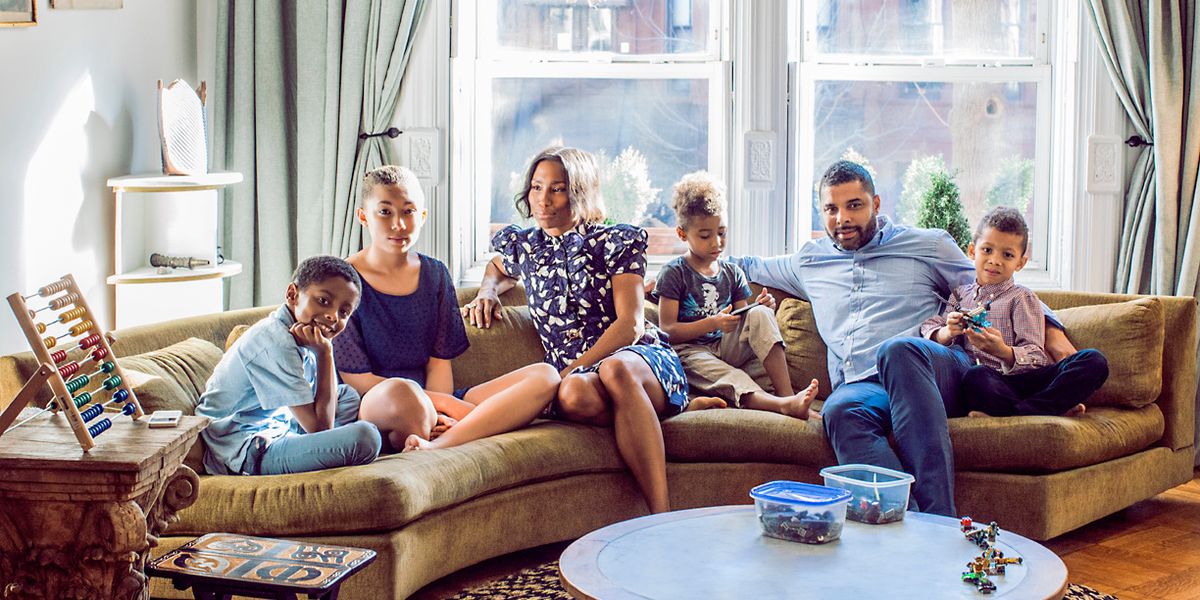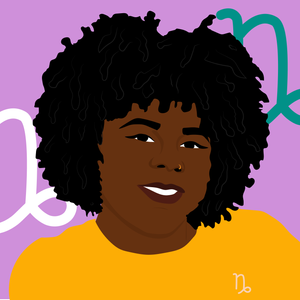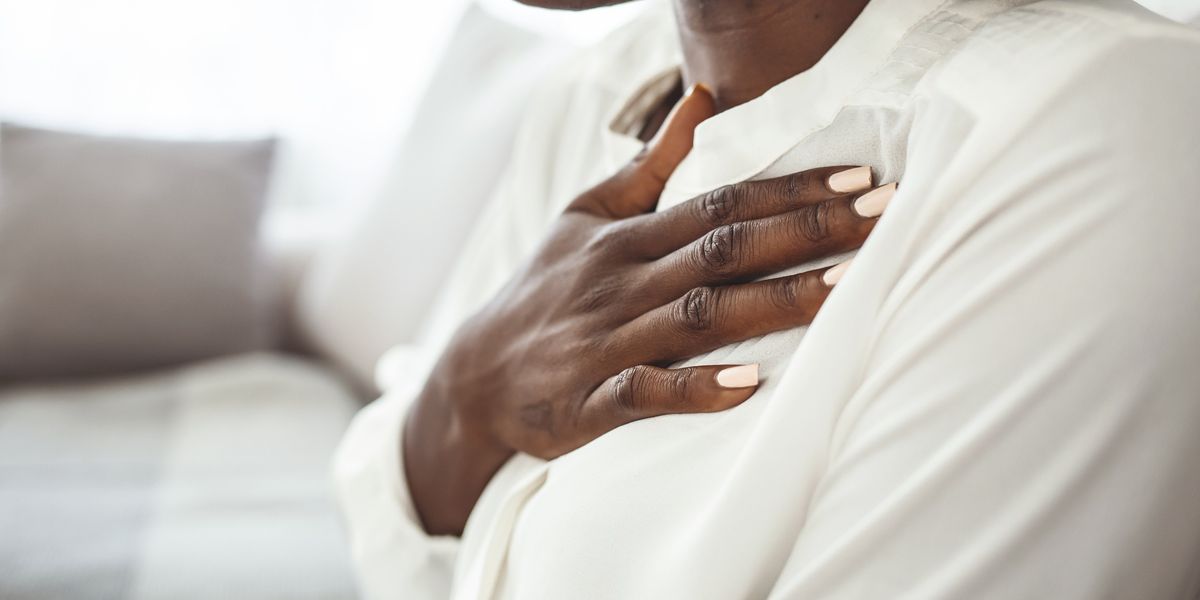
Jodie Patterson Encourages Black Moms To Boldly Accept Their Children For Who They Are
Shockwaves rippled through the Black community last spring when actress Gabrielle Union and her husband, retired basketball star Dwyane Wade, were spotted rallying around their daughter Zaya, as their parade float rode through Miami's annual pride event. At the time, the world knew Zaya as Zion. Over the next few months, we gained insight into Zaya's full story as she revealed her true essence to the public with the vocal support of her parents lighting her path. The Wades were framed as the standard for modern day Black familial acceptance by some, and condemned as blasphemers to those with hateful homophobic and transphobic ideologies.
Although celebrity tends to take up space in identity narratives, there are millions of families like the Wades all over this country. Social activist, entrepreneur and author Jodie Patterson is a proud member of this cohort. Her son, Penelope, told Patterson that he was a boy at 3 years old. Since that moment, the mom of five has worked relentlessly as an advocate for trans people and their families.
xoNecole spoke to Patterson about her family, the Black community, and why we have to adjust our language and understanding of gender to ensure the health and happiness of current and future generations of Black children.
xoNecole: There was uproar in our communities when Gabrielle Union and Dwyane Wade expressed support for their trans daughter, Zaya Wade. Why do you think Black people can be so resistant to parents accepting their kid for who they are?
Jodie Patterson: The time that I spent looking at it and thinking about it, it's not our people--it's just people. I think people have a harder time changing from one pattern to the next. I think people have a hard time going outside of their perspectives. But Gabrielle Union and Dwyane Wade and my family and millions of families are seeing our old habits no longer apply. The language we use around 'he' or 'she' and the associations we put to 'he' and 'she' no longer apply. And particularly, they don't apply to our children. Our children are asking us to see things differently, to say things differently, to live differently. And if we don't, if we aren't flexible like Gabrielle and Dwyane and others, we just we won't be with our children. We just won't be with our kids anymore.
What constructs of this adjustment did you personally battle with? Were there any beliefs you had to undo?
In my family, girls and boys have always done great things. Women have run businesses. Men have raised children. We are all very involved in our families and in our economic strength and in our community. But underlying underneath that there were certain biases that I held. You know? I was speaking to my girls in one way, and I was talking to my boys with a sterner voice. I was buying butterfly diapers for my daughter, and I was buying superhero diapers for my son. I had to not only change my language, but change the way I interacted with the world. I had to let all of my children experience all of life. And when I started doing that, I had to do the same thing because I realized I was holding myself back. I was trying to think of what a good woman should do--what a responsible wife was supposed to be saying and what a 50-year-old woman looked like. And in reality, I want to do everything in life. Not just the things carved out for 50-year-old women. So like this whole bias and all of the breaking down of barriers and constructs, it doesn't just apply to my trans kid it applied to all of my children and to myself and to the world.

Courtesy of Jodie Patterson
"I had to not only change my language, but change the way I interacted with the world. I had to let all of my children experience all of life. And when I started doing that, I had to do the same thing because I realized I was holding myself back. I was trying to think of what a good woman should do--what a responsible wife was supposed to be saying and what a 50-year-old woman looked like. And in reality, I want to do everything in life. Not just the things carved out for 50-year-old women."
How did you shield your child from feeling uneasy if you were uneasy or unsure about any of it?
It's difficult and tricky to figure out what to share with your children and what not to share, and then what to share with the world and what not to share. Like my life seems very open on social media, but not everything is expressed in the moment. Sometimes I take a step back to be quiet, to process, put it in perspective, to sort it out in my own brain and in my own heart, and then I start to share with my kids or with the world.
How did your husband react at the time? Were there any quarrels you all had to resolve as a couple to be on the same page for what raising Penelope looked like?
We were on the same page in love. The reason why I married him was because we all believed in family so deeply. But we weren't always on the same page. I wanted to go really fast. I wanted to be public. I wanted to share with everyone I knew. Dad was very respectful of the questions he still had, and what he wants, but much slower. It took us some time to find a middle ground. Our relationship didn't last as a couple, but the family structure around our children was never broken, ever. And it didn't break. You know, the fact that Penelope is transgender absolutely wasn't going to break us as a family.
Did you have your own “mourning” process? I’ve heard some folks describe accepting their child/partner’s trans identity felt like a loss to who they thought they were in some ways?
I know that that is a reality for many people. But I would say I did not experience any loss. In fact, we've never taken down pictures. Penelope never wanted to change his name. In fact, he said, "Why would I change my name? That's my grandmother's name, and I love her." I mourn some of the time that I hadn't understood. I mourn some of the time that I was confused; I mourn the time when I just wasn't getting it.

Courtesy of Jodie Patterson
"Penelope never wanted to change his name. In fact, he said, 'Why would I change my name? That's my grandmother's name, and I love her.' I mourn some of the time that I hadn't understood. I mourn some of the time that I was confused; I mourn the time when I just wasn't getting it."
You said there were behavioral differences in Penelope before he explained he was a boy. Is there any behavior you would advise parents to look out for in case their child can’t articulate how they are feeling yet?
We should ask ourselves, what is our child rejecting? Because Penelope would stomp on a dress and grab and reach for [his] brother's pants or brother's shirt. Penelope would throw the pink toothbrush out in the bathroom and pick up [his] brother's Spiderman toothbrush. So look for disruption. Look for anger. Look for bullying. Penelope had actually become a bully--pushing kids and pushing siblings around, really an angry kid. Well, he was angry with the place that we were putting Penelope in.
You had a Ted Talk called “Gender Is Obsolete”. How do you talk to people who still hold the belief that anatomy and gender are one and the same?
There's no amount of talking I can do or sharing I can do if the individual doesn't take one step in, one step on their own, to do some basic research. The basic research shows that scientifically that gender is not found in our anatomy. So even without my womb, I'm a woman--even without my breasts, even without my fallopian tubes, I'm a woman. And so when we look at the science around identity, it is in the brain. Identity is formed in the brain, not with trans people or certain people, but for all people. My identity is not in my vagina. So that's awesome.
"Even without my womb, I'm a woman--even without my breasts, even without my fallopian tubes, I'm a woman. And so when we look at the science around identity, it is in the brain. Identity is formed in the brain, not with trans people or certain people, but for all people. My identity is not in my vagina."
What advice would you give to soon-to-be mothers about labeling their child “boy” or "girl” before birth? Would you have done anything differently?
If what we think about our children turns out to be inaccurate, just shift. It's OK. Think about, "How flexible can I be? How flexible is my mind?" We have African naming ceremonies, like my children's father is from Ghana, and we did African naming ceremonies for each one. And there is a lot of that that I would do again and again and again if I could have my children again. And we would do some of the same ceremonies and rituals. And then, if it came to a point when it felt that I was inaccurately making assumptions of my kid or my kid was telling me, "Mom, that's not who I am," I would shift.
The Bold World: A Memoir of Family and Transformation is available on Amazon now. Patterson also has a children's book coming out called "Born Ready", which details Penelope's perspective on himself and his community.
Featured image courtesy of Jodie Patterson
- Conversations in Color: Jodie Patterson and Tiq Milan, November 9 ... ›
- Jodie Patterson (@jodie_GeorgiaNY) | Twitter ›
- Georgia by Jodie Patterson - Real Lives Of Working Women ›
- Jodie Patterson - Photos and Interview ›
- How Jodie Patterson's Personal History Affected Her Present With ... ›
- The Bold Jodie Patterson: An Interview with the Activist and Author ›
- Gender is obsolete | Jodie Patterson | TEDxMünchen - YouTube ›
- Activist Mom Jodie Patterson: How I Fight for My Trans Child ›
- The Bold World: Jodie Patterson discusses parenting memoir | EW ... ›
The Reality Of Living With Severe Asthma – As Told by 2 Women On Their Disease Journey
This post is in partnership with Amgen.
The seemingly simple task of taking a breath is something most of us don’t think twice about. But for people who live with severe asthma, breathing does not always come easily. Asthma, a chronic respiratory condition that inflames and narrows the airways in the lungs, affects millions of people worldwide – 5-10% of which live with severe asthma. Severe asthma is a chronic and lifelong condition that is unpredictable and can be difficult to manage. Though often invisible to the rest of the world, severe asthma is a not-so-silent companion for those who live with it, often interrupting schedules and impacting day-to-day life.
Among the many individuals who battle severe asthma, Black women face a unique set of challenges. It's not uncommon for us to go years without a proper diagnosis, and finding the right treatment often requires some trial and error. Thankfully, all hope is not lost for those who may be fighting to get their severe asthma under control. We spoke with Juanita Brown Ingram, Esq. and Jania Watson, two inspiring Black women who have been living with severe asthma and have found strength, resilience, and a sense of purpose in their journeys.
Juanita Brown Ingram, Esq.
Juanita Ingram has a resume that would make anyone’s jaw drop. On top of being recently crowned Mrs. Universe, she’s also an accomplished attorney, filmmaker, and philanthropist. From the outside, it seems there’s nothing this talented woman won’t try, and likely succeed at. In her everyday life, however, Juanita exercises a lot more caution. From a young age, Juanita has struggled with severe asthma. Her symptoms were always exacerbated by common illnesses like a cold or flu. “I've heard these stories of my breathing struggles, but I remember distinctly when I was younger not being able to breathe every time I got a virus,” says Ingram. “I remember missing a lot of school and crying a lot because asthma is painful. I [was taken] to see my doctor often if I got sick with anything so I was hypervigilant as a child, and I still am.”
Today, Juanita says her symptoms are best managed when she’s working closely with her care team, avoiding getting sick and staying ahead of any symptoms. Ingram said she’s been blessed with skilled doctors who are just as vigilant of her symptoms as she is. While competing in the Mrs. Universe competition, Juanita took extra care to stay clear of other competitors to ensure she didn’t catch a cold or virus that would trigger her severe asthma. “I would stand off to the side and sometimes that could be taken as ‘oh, she thinks she's better than everybody else.’ But if I get sick during a pageant, I'm done. I had to compete with that in mind because my sickness doesn't look like everybody else's sickness.”
Even when her symptoms are under control, living with severe asthma still presents challenges. Juanita relies on her strong support system to overcome the hurdles caused by a lack of understanding from the public, “I think that there's a lot of lack of awareness about how serious severe asthma is. I would [also] tell women to advocate and to trust their intuition and not to allow someone to dismiss what you're experiencing.”
Jania Watson
Jania, a content creator from Atlanta, Georgia, has been living with severe asthma for many years. Thanks to early testing by asthma specialists, Jania was diagnosed with severe asthma as a child after experiencing frequent flare-ups and challenges in her day-to-day life. “I specifically remember, I was starting school, and we were moving into a new house. One of the triggers for me and my younger sister at the time were certain types of carpets. We had just moved into this new house and within weeks of us being there, my parents literally had to pay for all new carpet in the house.”
As Jania grew older, she was suffering from fewer flare-ups and thought her asthma was well under control. However, a trip back to her doctor during high school revealed that her severe asthma was affecting her more than she realized. “That was the first time in a long time I had to do a breathing test,” she describes. “The doctor had me take a deep breath in and blow into a machine to test my breathing. They told me to blow as hard as I could. And I was doing it. I was giving everything I got. [My dad and the doctor] were looking at me like ‘girl, stop playing.’ And at that point [it confirmed] I still have severe asthma because I've given it all I got. It doesn't really go away, but I just learned how to help manage it better.”
Jania recognizes that people who aren’t living with asthma, may not understand the disease and mistake it for something less serious. Or there could be others who think their symptoms are minor, and not worth bringing up. So, for Jania, communicating with others about her diagnosis is key. “Having severe asthma [flare-ups] in some cases looks very similar to being out of shape,” she said. “But this is a chronic illness that I was born with. This is just something that I live with that I've been dealing with. And I think it's important for people to know because that determines the next steps. [They might ask] ‘Do you need a bottle of water, or do you need an inhaler? Do you need to take a break, or do we need to take you to the hospital?’ So, I think letting the people around you know what's going on, just in case anything were to happen plays a lot into it as well.”
Like Juanita, Jania’s journey has been marked by ups and downs, but she remains an unwavering advocate for asthma awareness and support within the Black community. She hopes that her story can be an inspiration to other women with asthma who may not yet have their symptoms under control. “There's still life to be lived outside of having severe asthma. It is always going to be there, but it's not meant to stop you from living your life. That’s why learning how to manage it and also having that support system around you, is so important.”
By sharing their journeys, Juanita and Jania hope to encourage others to embrace their conditions, obtain a proper management plan from a doctor or asthma specialist like a pulmonologist or allergist, and contribute to the improvement of asthma awareness and support, not only within the Black community, but for all individuals living with severe asthma.
Read more stories from others like Juanita and Jania on Amgen.com, or visit Uncontrolled Asthma In Black Women | BREAK THE CYCLE to find support and resources.
Unleash Your Inner Goddess With These 16 Bubble Braid Looks
Ever since I found the joy that is twisting up my hair with added hair in an effortless protective style that can be achieved in four hours or less (and in the comfort of my own home), I've been obsessed with simple hairstyles that are easy to do and not a pain to maintain.
Throwing some simple albeit a little messy twists into my hair whenever I want to tuck my natural hair away for a bit or have the ease or a break from daily manipulation is a welcomed change, especially when you are a lazy natural who never quite got the hang of doing her own hair beyond rocking an afro.
Another style that has been luring me into trying more hairstyles in my own at home? The much-talked-about bubble braids, or "poodle puffs," that have been trending around the web for a minute. The fun and playful style got its name from the small "bubbles" or "puffs" of the rubberbanded sections that make up each ponytail/braid. Bubble braids can be created with your own hair or with added length through extensions and can vary in length depending on whether you're opting for a short, medium, or long length.
Another variation of the style, sometimes called "bubble ponytails," can be achieved using a single ponytail that would then use elastics to rubberband large sections into an added pony. This one feels like more of a cross between that and classic twist styles.
I first came across them on my FYP when a creator named Ava shared a TikTok of herself in different stages of styling and installing bubble braids into her hair.
Bubble braids for da WINN
@ava_tocloo Bubble braids for da WINN
Tell me that didn't just inspire you to go cop some packs of Afro Kinky Twist hair and get to work! In a separate TikTok, the creator also showed her audience an in-depth tutorial on how to achieve the style at home. Check that out here.
For its versatility, personality, and simplicity, bubble braids should most definitely be on your radar in 2024 if the protective style isn't already. Need more motivation? Keep reading for some bubble braid styles we are currently loving.
16 Best Bubble Braids Styles
@ava.tocloo
@isasnovaes
@brianna.who
@curlielexi
@curlielexi #stitch with @⭑ Ava ⭑ I was inspired to do poodle puffs... bubble braids.. however you call it🥰 #poodlepuffs #bubblebraids #protectivestyles
@satur.nine
@kayratheodore
@queen_esie
@plus_237
@saturnbaby__
@saturnbaby__ Underated protective style 💗 #naturalhair #naturalhairstyles #poodlepuffs
Underrated protective style 💗 #naturalhair #naturalhairstyles #poodlepuffs
@the.priscilla.in.me
@gjdallas
@nextawe_pturals
@claireateku
@raerays
@lokebadt
@lokebadt I forgot how much I liked this song🔥 #poodlepuffs #blackgirltiktok #gingerhair #copperhair #4chair #backtoschoolhairstyles #fyp #puffbraids #bubblebraids #marleytwist
@ohsolovelyrae
Let’s make things inbox official! Sign up for the xoNecole newsletter for daily love, wellness, career, and exclusive content delivered straight to your inbox.
Featured image via @ava_tocloo/Instagram











